These are the 10 top-performing racers and trainers most loved by the guys on our test team.
We’re constantly testing the latest running shoes in our lab and on the feet of our 275-runner-strong wear-test team. About half of those runners are men—and most importantly, they’re an extremely diverse group of guys. Some are seriously speedy dudes hitting sky-high mileage and knocking on the door of the Olympic Trials; others are just getting into running or coming back from injury. We have runners of all shapes, sizes, ages, abilities, and backgrounds—from full-time English teachers and new dads to night-shift nurses and grandfathers.
The one thing they’ve all got in common is that they’re passionate about running, and log at least 40 kilometres per week in their test shoes. Chances are, there’s a shoe here that you’ll love as much as they do, and you can scroll deeper for a variety of shoes that cater to different preferences for stability and cushioning.
Stability
In terms of running shoe design, stability refers to a shoe’s ability to support good running form. Typically, that means an optimal level of pronation (more on that here). If you’re an overpronator—your feet roll inward excessively—and prefer stability, these shoes have features to help counter that movement. These include firmer foams in key areas of the midsole, like a medial post, or additional material on the edge of the sole to prevent the foot from twisting, like the GuideRails on Brooks’s Adrenaline GTS. If you don’t overpronate, you’ll likely prefer a “neutral” shoe, which doesn’t have extra support features and won’t interfere with your stride.
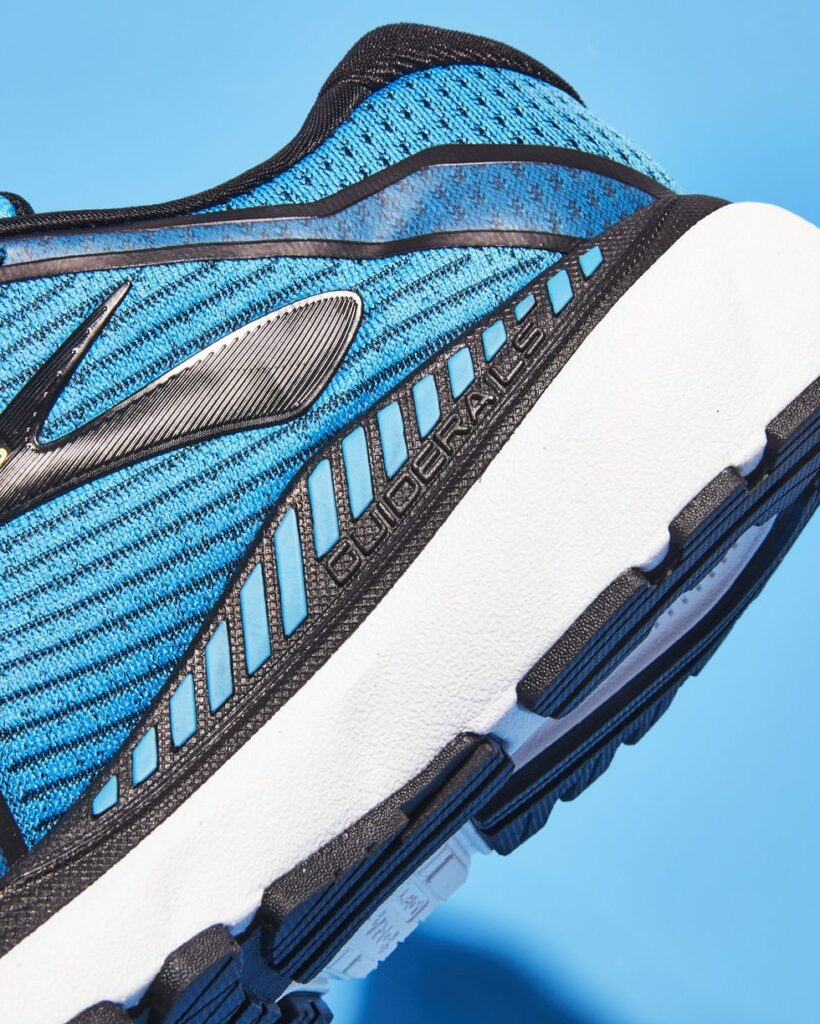
Trevor Raab
GuideRails offer a less aggressive approach to stability that even neutral runners can rely on for extra support.
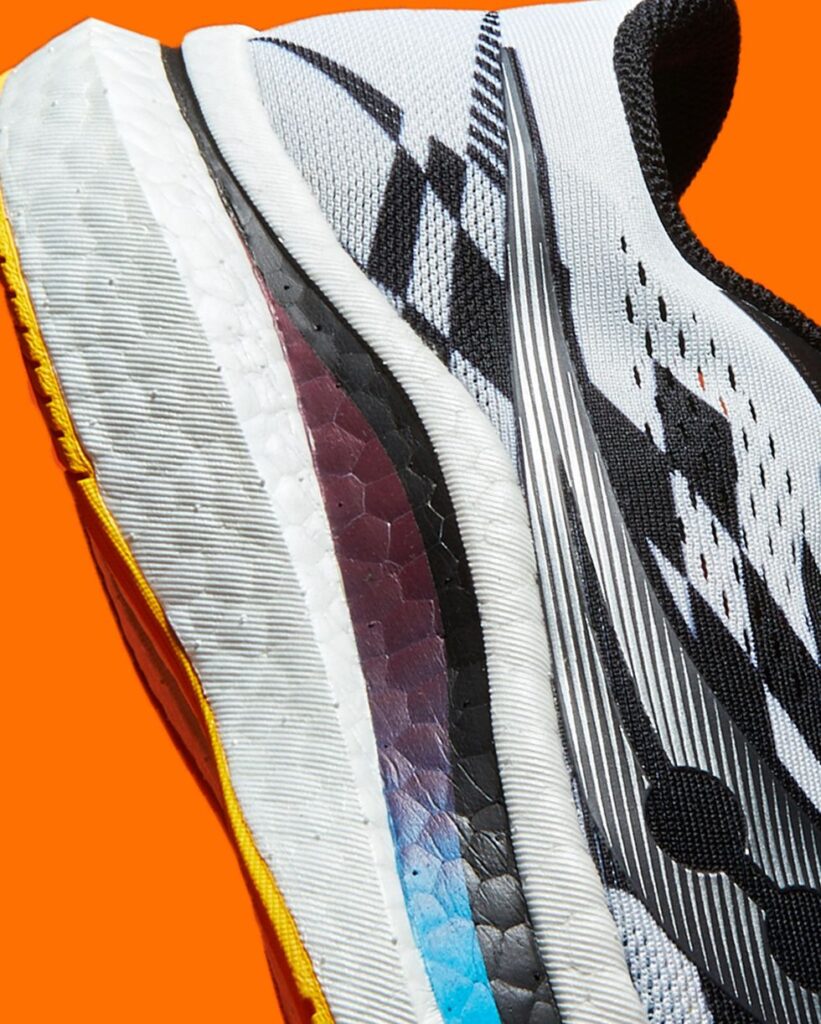
Lakota Gambill
Saucony fuses together pellets of PEBA-based foam using steam and pressure to create the Endorphin Pro’s durable yet bouncy midsole cushioning.
Cushioning
This is an area where opinions vary widely. Runners who focus on speed may prefer a firmer shoe that gives them a good feel for the ground. Others like something plush that absorbs impact forces. In the past, you usually had to sacrifice some cushioning in order to find a shoe that felt lightweight enough to help shave fractions of a second off your finish time. Thanks to newer foam technology, that’s no longer the case. The Asics Superblast, one of the most cushioned shoes we’ve tested, tips the scale at only 8.6 ounces for a men’s size 9. That’s important for longer runs, because the extra cushioning can reduce aches in tired feet and joints.
How We Test and Select
To select these shoes, we consulted Runner-in-Chief Jeff Dengate for his recommendations on the top running shoes for men, and we also relied on feedback from hundreds of male runners on our wear-test team. After putting countless pairs through the wringer and evaluating the data, we’ve rounded up some of the standouts that have received especially high marks and praise from our male testers.
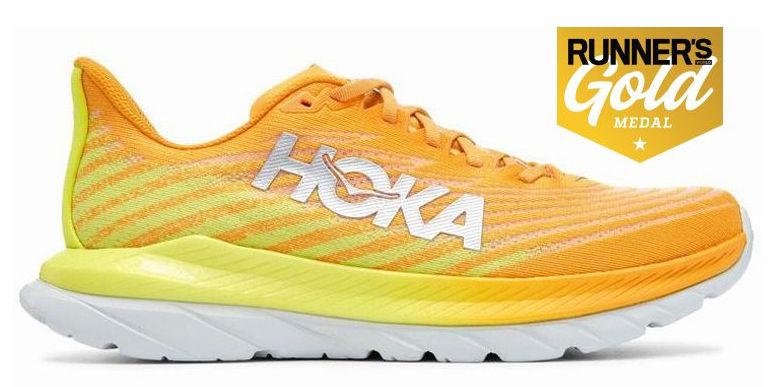
BEST OVERALL
Hoka Mach 5
$179.99-$259.99 AT HOKA.COM
PROS
- New Profly+ midsole is plush and more responsive
- Lighter than Mach 4
CONS
- Little traction in wet and wintry conditions
Key Specs
| Weight | 230g (M9) |
|---|---|
| Type | Neutral Road |
| Drop | 5 mm |
| Heel Stack | 29 mm |
| Forefoot Stack | 24 mm |
A cushioned road shoe that feels as light and explosive as a race shoe—but still sturdy enough for long training runs—the new Mach 5 replaces its predecessor as perhaps our favorite Hoka ever. To build this versatile trainer, Hoka kept speedy design features from the brand’s race-oriented Carbon X 3 and Rocket X 2 (like propulsive energy return and a sportier, more streamlined upper that hugs your foot) while forgoing the carbon plate. But the big news for v5 is an upgrade to the brand’s usual generous cushioning. The shoe now uses a tweaked formulation of Profly+ midsole foam, which provides plenty of zoom and bounce.
The early-stage Meta-Rocker (a curved sole shape) hasn’t changed; it still rolls you through heel-to-toe transitions quickly. Some of us missed the Mach 4’s oversized heel tab that made it easy to get your feet in and out, but the omission helped the 5 drop nearly a half ounce in weight. Overall, it’s a shoe that excels at everything from interval track workouts to weekend long runs and recovery jogs.
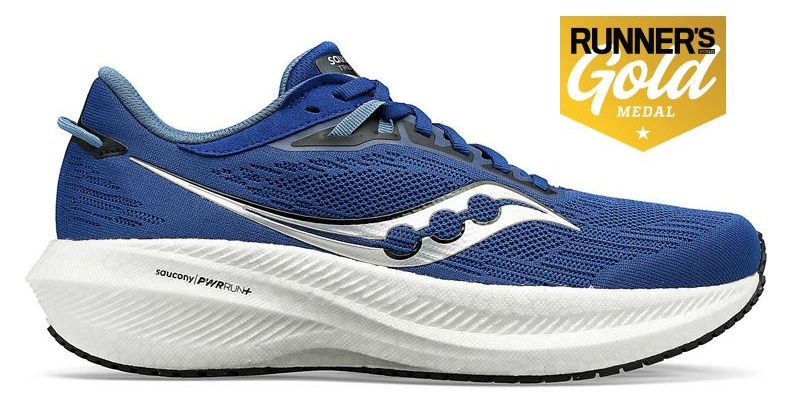
BEST FOR LONG RUNS
Saucony Triumph 21
$259.99 on Saucony.com
PROS
- Plush upper with secure midfoot lockdown
- Smooth ride and excellent energy return
- Good outsole grip and durability
CONS
- Slightly heavier than Triumph 20
- Toebox feels a bit narrow
Key Specs
| Weight | 277g (M9) |
|---|---|
| Type | Neutral Road |
| Drop | 10 mm |
| Heel Stack | 37 mm |
| Forefoot Stack | 27 mm |
Somehow, the Triumph just keeps getting better. Our wear-testers almost unanimously gave the daily trainer high ratings in every category, from fit to comfort to cushioning. Even the one tester who gave less-than-impressed feedback on the shoe’s weight and speed couldn’t deny the Triumph 21 a high score. “This shoe does a lot right, with its cozy fit and interior,” he said. From the lacing to the midsole, that coziness won out as our testers’ favorite feature.
Saucony redesigned the flat-knit upper and lacing in this iteration for a more secure fit. And the pillowy shock absorber underfoot, a Pwrrun+ midsole, is springier and 28 percent lighter than the original Pwrrun foam.
“These were not the snappiest shoes I have worn,” said another tester, an overpronator and midfoot-striker. “But despite being so cushioned, they never felt too dense or like they were sapping my energy.” This tester drew comparisons to the Asics Gel-Kayano, a model they’ve run in for more than 1,600 kilometres. “Though I’m only 209 kilometres into the Triumph, they feel just like they did on the first run.”
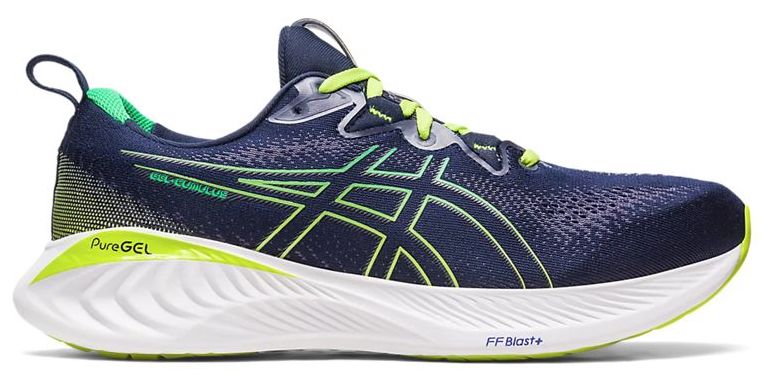
Asics Gel-Cumulus 25
$220 AUD at ASICS.com
PROS
- Lighter than the Gel-Cumulus 24
- Smooth ride with excellent shock absorption
- Upper is roomy and soft without feeling sloppy
CONS
- Runs slightly long
- Upper mesh can trap heat and moisture
Key Specs
| Weight | 266g (M9) |
|---|---|
| Type | Neutral Road |
| Drop | 8 mm |
| Heel Stack | 38 mm |
| Forefoot Stack | 30 mm |
Gel-Kayano, Gel-Cumulus, Gel-Nimbus. These titans all have the same first name, and it just got an upgrade. Pure Gel is the lighter, softer version of the brand’s hallmark cushioning. It’s still a bit heavier than midsole foam, so you’ll see it used in workhorse trainers rather than racing models, but not much is needed to reap its benefits. Asics puts a small wedge of the new material in the heel, just enough to smooth landings and absorb shock without weighing you down. Only, you won’t see the squishy gel peeking out like in prior versions of the shoe; Pure Gel blends in with the rest of the midsole, now made of Flytefoam Blast+. Swapping in the light and springy foam lets Asics add 4mm to the midsole, but actually reduces weight from the Gel-Cumulus 24.
Testers said the Cumulus is surprisingly light for its “nice, thick, and foamy” workhorse sole, but it does sacrifice some pep underfoot. “When I wear racers like Asics’s Magic Speed or Saucony’s Endorphin Speed, I feel like I’m being rocked onto my toes, making me more efficient and pushing me forward. While I didn’t feel that sensation in this shoe, it’s one of the most comfortable I’ve worn,” said one tester.
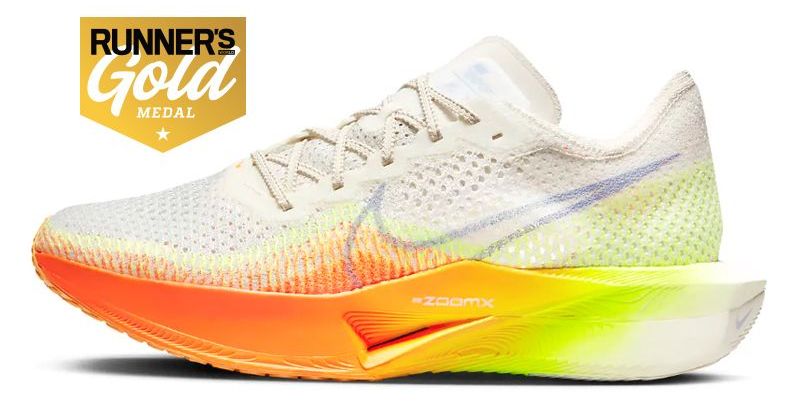
BEST FOR ROAD RACING
Nike Vaporfly 3
$330 AUD at Nike
PROS
- More stable than the Vaporfly 2
- Extremely high energy return
CONS
- Upper lacks flexibility
Key Specs
| Weight | 200g (M10) |
|---|---|
| Type | Road Racing |
| Drop | 8 mm |
| Heel Stack | 40 mm |
| Forefoot Stack | 32 mm |
Nike overhauled the Vaporfly from the rubber up, looking to make the third version the lightest yet. In our men’s size 12, we see only a 0.1-ounce drop from version 2 (our pink pair of the first Next% was 0.4 ounces lighter still). So, it’s not the lightest ever, but it’s still lighter than competitors like the Asics MetaSpeed Sky+, Saucony Endorphin Pro 3, New Balance FuelCell SuperComp Elite v3, Adidas Adizero Adios Pro 3, and Puma Deviate Nitro Elite 2.
One attempt to shave weight came in the way Nike shaped the midsole. It’s still using the same Peba-based material for the foam (Nike calls it ZoomX), which delivers top-of-the-line energy return. That foam is already exceptionally lightweight, but Nike added a cutout on the lateral sidewall—your foot doesn’t need support there—and a small channel under the midfoot to reduce material and shave a couple grams.
The shoe is also equipped with a carbon-fiber plate. This high-tech combination of plate and foam allows elite marathoners to race under a five-minute pace, but it’s not just for the pros. Even at slower speeds, the shoe still feels exceptionally propulsive and energetic, making every stride a little more efficient and less taxing. Overall, it just might be the speediest and bounciest shoe we’ve tested yet.
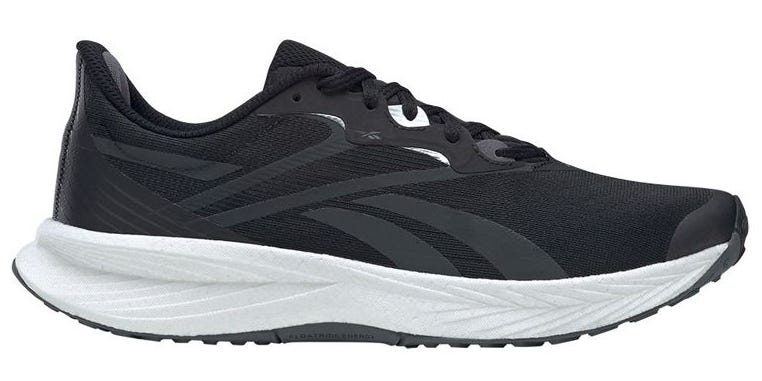
BEST BUDGET SHOE
Reebok Floatride Energy 5
$160 AUD on Reebok.com
PROS
- Responsive TPU-based midsole
- Midsole plate lends support through toe-off
- Good outsole durability
CONS
- Laces can be difficult to tighten
- Less suited for racing
Key Specs
| Weight | 257g (M9) |
|---|---|
| Type | Neutral Road |
| Drop | 8 mm |
| Heel Stack | 27 mm |
| Forefoot Stack | 19 mm |
For running performance and style for $110, it’s tough to beat the newest Floatride Energy 5. Compared to the Floatride Run Fast—which used a lighter and bouncier Pebax foam—this shoe isn’t quite as propulsive. But its TPU-based midsole, now with a plate beneath the midfoot, still feels responsive and lends extra support when fatigue sets in an hour or so into a long run. Our wear-testers who previously ran in the Asics Novablast and Nike Invincible praised the Floatride Energy 5’s versatility for both double-digit kilometres and shorter efforts.
“Soft enough to wear on a recovery day, and responsive enough to wear on a tempo run,” one said. “Although these shoes are pretty lightweight, I still feel like there is something substantial under my foot. If I were going on a trip and could only bring one pair of shoes, I’d take these.”
Plus, the Floatride Energy 5’s upper feels comfier than its previous two versions. It’s a return to the original Forever Floatride’s sturdier roots. To emphasize this, we go back to Floatride-obsessed Runner-in-Chief Jeff Dengate. “I’ve always loved that Reebok shoe,” he said. “V3 or 4 felt a little budget. This one is a return to cheap thrills.”
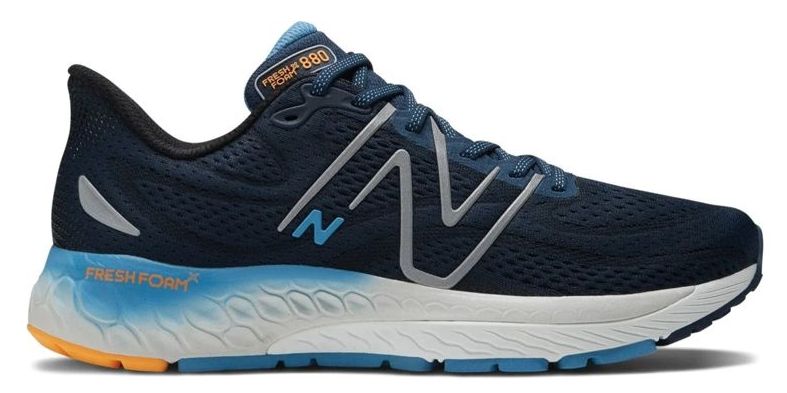
BEST DAILY TRAINER
New Balance Fresh Foam X 880 v13
$230 AUD on New Balance.com
PROS
- Thick, extremely durable outsole rubber
- More secure lacing with improved midfoot lockdown
- Soft cushioning and smooth ride
CONS
- Heavier than the 880 v12
- Toebox feels slightly narrower than v12
Key Specs
| Weight | 300g (M9) |
|---|---|
| Type | Neutral Road |
| Drop | 10 mm |
| Heel Stack | 32 mm |
| Forefoot Stack | 22 mm |
Last year, New Balance gave the 880’s midsole a substantial, carefully-considered update. Its new dual-density construction overlapped a softer portion of Fresh Foam in the heel with a firmer, denser layer of EVA-based material beneath the midfoot that carried you through toe-off. The result was a ride that comfortably soaked up shock for heel strikers—the vast majority of runners—while keeping turnover smooth and peppy. That much is unchanged for the v13. For this update, New Balance focused on the upper, swapping in engineered mesh with a snugger fit to lockdown the foot noticeably better than its predecessor. (Testers told us this version does feel narrower. But, it’s available in several widths to accommodate a variety of foot shapes.)
“The 880 still takes the prize for being my favorite line of shoes,” one tester said. The generous blown rubber outsole handles high-volume marathon training well—especially if the bulk of your runs are on slick roads and sidewalks. It’s not the lightest shoe, but it’s nimble enough to keep you cruising without clunkiness through double-digit mileage. And if you regularly bounce from your daily run to long hours on your feet, this is a great candidate that can keep up for both. (For those needing less support but a bit more speed and pep, we recommend the new FuelCell Rebel v3.)
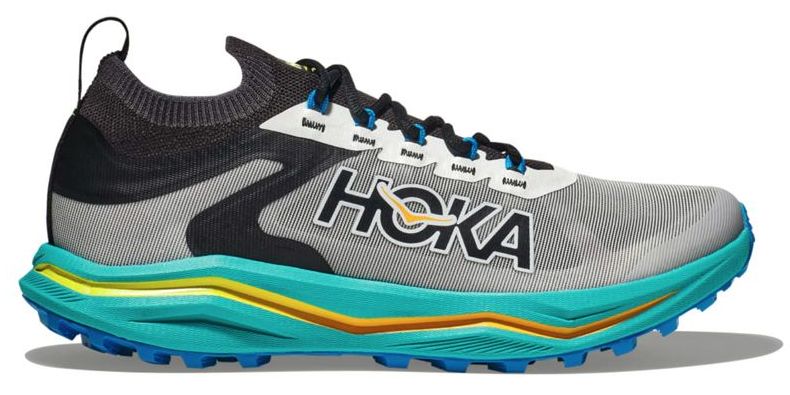
BEST LIGHTWEIGHT TRAIL SHOE
Hoka Zinal 2
PROS
- Lighter than the Zinal v1
- Deeper lugs improve grip on muddy trails
- Gaiter-style collar keeps out dirt and debris
CONS
- Some testers wanted more cushioning
- No rock plate
Key Specs
| Weight | 209g (M9) |
|---|---|
| Type | Trail |
| Drop | 5 mm |
| Heel Stack | 30 mm |
| Forefoot Stack | 25 mm |
| Lug Depth | 5 mm |
This shoe’s name—taken from the Sierre-Zinal, a 31km race with 7,218 feet of elevation gain and a 3,609-foot descent—is perhaps the only aspect that remains untouched in the Zinal’s sequel. The Zinal 2 gets a new knit ankle collar, which does help reduce the amount of dirt and debris that can enter the shoe, but it’s not a replacement for the real thing. This knit portion provides a snug-against-skin feeling when you first pop it onto your foot, and it maintains a good hold on your heel and ankle while running over technical terrain.
The outsole is where things really get exciting, and where the biggest improvements come over the original Zinal. Hoka went with a full-coverage layer of Vibram Megagrip Litebase. It had Litebase before, but the lug pattern now uses Vibram’s “Traction Lug” design, which stacks even tinier lugs atop the tiny lugs. This increases surface area and creates more angles to allow the shoe to catch onto any imperfections in your running surface. The lugs are also deeper, so when the ground does get soft, the shoe penetrates a bit more to give you a better chance of finding something firm enough to push off of.
“I’ve worn the Zinal on runs up to 38 kilometres without issues, and the full-coverage outsole rubber added protection that would have let through rock strikes on v1,” said video producer Pat Heine. “While it’s not intended for racing ultras, it could certainly be a race-day option for up to 50K.”
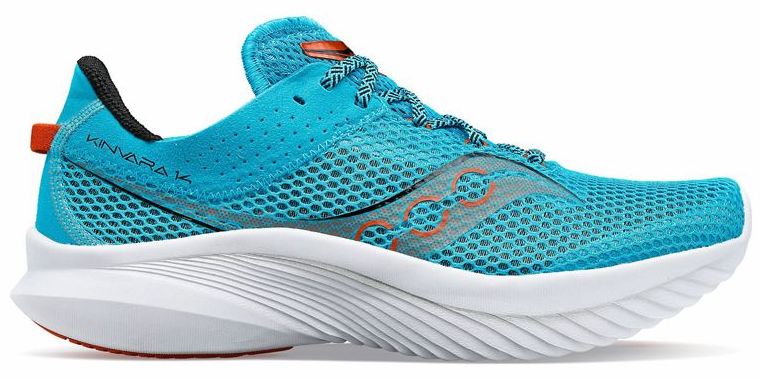
BEST FOR SPEEDWORK
Saucony Kinvara 14
$199.99 AUD on Saucony.com
PROS
- More breathable upper with locked-in fit
- Flexible toe-off and good ground connection
- Lighter than the Kinvara 13
CONS
- Narrow forefoot and toebox
- Less stable than the Kinvara 13
Key Specs
| Weight | 190g (M9) |
|---|---|
| Type | Neutral Road |
| Drop | 4 mm |
| Heel Stack | 31 mm |
| Forefoot Stack | 27 mm |
Saucony wanted the Kinvara 14 to be more of a “do-it-all” shoe that could run the gamut as a lightweight daily trainer and even a budget racer. For that reason, the brand added 3mm of cushioning, giving the midsole a similar setup to its hallmark neutral daily trainer (the Ride). But Saucony also lightened this version for the start line by borrowing the same airy, fishnet-like mesh from its top-tier speedy model (the Endorphin Pro 3).
“This shoe is very well-balanced for an everyday comfortable ride that can still respond if you want to drop those last kilometres of your long run with a little bit of extra spice,” said one tester. “The work is on you to keep this shoe upright and get your foot on the ground in an efficient way. If you need extra support and guidance, look elsewhere.”
Since both shoes use Pwrrun foam and a Pwrrun+ sockliner, it’s not surprising that the Kinvara 14 feels like a stripped-down version of the Ride 16. The experience is nimbler and firmer underfoot—one that’s fun because it’s lean and fast and snappy, not bouncy and squishy-soft.
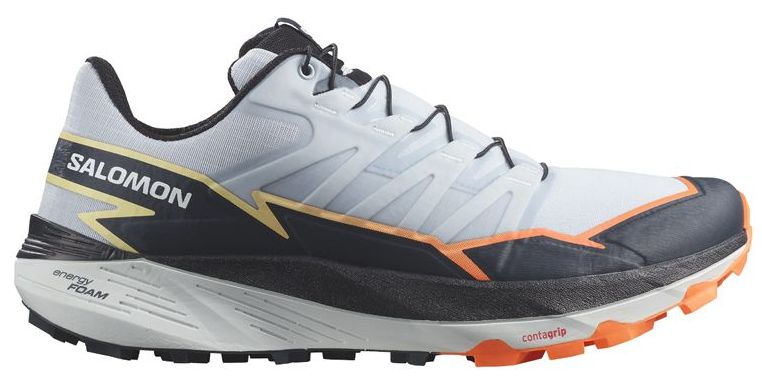
BEST CUSHIONED TRAIL SHOE
Salomon Thundercross
$189.99 AUD
PROS
- Quick-lacing allows for fast adjustments
- New lug pattern provides excellent grip on muddy terrain
- Durable, hydrophobic upper material
- New midsole foam feels softer
CONS
- On the heavier side
- Upper is less breathable
Key Specs
| Weight | 283g (M9) |
|---|---|
| Type | Trail |
| Drop | 4 mm |
| Heel Stack | 31 mm |
| Forefoot Stack | 27 mm |
| Lug Depth | 5 mm |
Built to basically be the Jeep of Salomons, the Thundercross gives you grip and protection to go anywhere—on or off trail—in any conditions. Video producer Pat Heine tested the Thundercross on the rocky Appalachian Trail in Pennsylvania near Runner’s World HQ, as well as during Rickey Gates’s Hut Run Hut—a six-day camping excursion that includes one-hundred kilometres of running, bushwacking off-trail, and scrambling across Colorado ridgelines. Overall, he found the Thundercross marries the comfort of Salomon’s Sense Ride 5 with the Speedcross’s chops on technical terrain.
“Cushioning under the forefoot is where I’ve always felt the Cross line was lacking, and while the Thundercross still feels quite firm, it gets more foam underfoot,” Heine said. “And, this generation of Salomon’s Energy Foam midsole is slightly softer, so it’s more forgiving for runners who don’t like to feel any hard ground through their shoes.”
The upper is not built with weight savings in mind; it’s made for protection on your most adventurous runs. Thick overlays around the toe help blunt stubs on rocks, and a panel covers most of the tongue to reduce the chance of dirt sneaking in under the laces. It also kept Heine’s feet dry during quick splashes through streams.

BEST STABILITY SHOE
Brooks Adrenaline GTS 23
$259.99 AUD
PROS
- Good arch support
- Lighter than the Adrenaline GTS 22
CONS
- Less suited for speed workouts
Key Specs
| Weight | 286 (M9) |
|---|---|
| Type | Stability Road |
| Drop | 12 mm |
| Heel Stack | 36 mm |
| Forefoot Stack | 24 mm |
The Adrenaline GTS is Brooks’s well-loved stability shoe that has a lighter, less obtrusive GuideRails system, rather than a medial post, to provide support. The 23rd iteration has that same design, which places material along the edges of the sole to keep your feet in alignment. (This makes it accessible for both overpronators and neutral runners, since the extra support engages only if you need it). Overall, the shoe feels slightly softer and smoother than previous models, thanks to the new DNA Loft v2 foam that spans the full length of the midsole. The Adrenaline still provides excellent shock absorption, and the rubber outsole delivers great traction and durability for high-mileage runners.